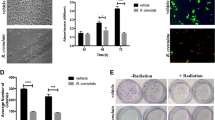Abstract
Basal cell carcinoma, a noninvasive and rarely metastatic tumor, correlates with clinical and histological involvement of basal epithelial cells. It occurs due to dysregulation of hedgehog-patched1 signaling pathway. The current study was conducted to evaluate the in vitro cytotoxic effects of Cupressus sempervirens methanolic extract against primary basal cell carcinoma cells, over a period of 48 h. We measured protein level of Annexin-V and the leakage rate of lactate dehydrogenase in cells being exposed to 420 μM extract. In addition to transcript levels of PTCH-1, a receptor of of hedgehog signaling pathway, angiogenic activity of tumor cells were determined in terms of the amount of vascular endothelial growth factor and angiopoietin-2, and metastatic levels of matrix metalloproteinase 2 and 9.
The cytotoxicity test results showed that BCC cells survival decreased dose-dependently over 48 h after exposure to plant extract. The expression of Annexin-V was induced (p < 0.05) in treated cells which coincided with raised levels of lactate dehydrogenase in supernatant media (p < 0.05). Noticeably, the expression of PTCH-1, vascular endothelial growth factor, angiopoietin-2, and matrix metalloproteinase 2 and 9 were robustly decreased. Interestingly, 6-month clinical trial follow-up of C. sempervirens extract 5% ointment showed antitumor activity against cutaneous basal cell carcinoma by the reduction of tumor and inflammatory cells replaced with fibrotic stroma. The data of present experiment may suggest that the methanolic extracts of C. sempervirens possess oncostatic and cytotoxic properties, and therefore, can be prescribed as natural protective and therapeutic ingredients for basal cell associate cutaneous tumor.




Similar content being viewed by others
References
Bale AE, Yu K-p (2001) The hedgehog pathway and basal cell carcinomas. Hum Mol Genet:757–762. doi:10.1093/hmg/10.7.757
Carrasco E et al (2014) Novel merosesquiterpene exerts a potent antitumor activity against breast cancer cells in vitro and in vivo. Eur J Med Chem 79:1–12
Chen ML, Lin YH, Yang CM, Hu ML (2012) Lycopene inhibits angiogenesis both in vitro and in vivo by inhibiting MMP-2/uPA system through VEGFR2-mediated PI3K-Akt and ERK/p38 signaling pathways. Mol Nutr Food Res 56:889–899
Cheraghi O et al (2016) Potent anti-angiogenic and cytotoxic effect of conferone on human colorectal adenocarcinoma HT-29 cells. Phytomedicine 23:398–405
Folkman J (2002) Role of angiogenesis in tumor growth and metastasis. Semin Oncol 29(6 Suppl 16):15–18
Gailani MR, Bale AE (1997) Developmental genes and cancer: role of patched in basal cell carcinoma of the skin. J Natl Cancer Inst 89:1103–1109
Gorlin RJ (1987) Nevoid basal-cell carcinoma syndrome. Medicine 66:98–113
Heinrich M, Bremner P (2006) Ethnobotany and ethnopharmacy—their role for anti-cancer drug development. Curr Drug Targets 7:239–245
Iannacone MR et al (2013) Case–control study of cutaneous human papillomavirus infection in basal cell carcinoma of the skin. J Invest Dermatol 133:1512–1520
Kasper M, Jaks V, Hohl D, Toftgård R (2012) Basal cell carcinoma—molecular biology and potential new therapies. J Clin Invest 122:455–463
Kumar KH, Sunila E, Kuttan G, Preethi K, Venugopal CN, Kuttan R (2007) Inhibition of chemically induced carcinogenesis by drugs used in homeopathic medicine. Asian Pac J Cancer Prev 8:98–102
Lee J-H, Piao MS, Choi J-Y, Yun SJ, Lee J-B, Lee S-C (2013) Up-regulation of cyclooxygenase 2 and matrix metalloproteinases-2 and -9 in cutaneous squamous cell carcinoma: active role of inflammation and tissue remodeling in carcinogenesis. Ann Dermatol 25:145–151
Loizzo M, Tundis R, Menichini F, Saab A, Statti G (2008) Antiproliferative effects of essential oils and their major constituents in human renal adenocarcinoma and amelanotic melanoma cells. Cell Prolif 41:1002–1012
Mehrgan H, Mojab F, Pakdaman S, Poursaeed M (2008) Antibacterial activity of Thymus pubescens methanolic extract. Iran J Pharm Res 7:291–295
Nitzki F, Becker M, Frommhold A, Schulz-Schaeffer W, Hahn H (2012) Patched knockout mouse models of basal cell carcinoma. J Skin Cancer 2012:907543
Nyberg P, Xie L, Kalluri R (2005) Endogenous inhibitors of angiogenesis. Cancer Res 65:3967–3979
Taheri FH, Seyedolmohadesin M, Bayat M, Mahdavi M, Yazdi MH, Eslamifar A, Abolhassani M (2013) The effect of Candida albicans systemic infection on matrix metalloproteinases in breast cancer bearing BALB/c mice. Iran J Allergy Asthma Immunol 12:81–85
Tebcherani AJ, de Andrade HF, Sotto MN (2012) Diagnostic utility of immunohistochemistry in distinguishing trichoepithelioma and basal cell carcinoma: evaluation using tissue microarray samples. Mod Pathol 25:1345–1353
Undén AB, Zaphiropoulos PG, Bruce K, Toftgård R, Ståhle-Bäckdahl M (1997) Human patched (PTCH) mRNA is overexpressed consistently in tumor cells of both familial and sporadic basal cell carcinoma. Cancer Res 57:2336–2340
Van Der Riet P et al (1994) Progression of basal cell carcinoma through loss of chromosome 9q and inactivation of a single p53 allele. Cancer Res 54:25–27
Verma V et al (2014) Labda-8 (17), 12, 14-trien-19-oic acid contained in fruits of Cupressus sempervirens suppresses benign prostatic hyperplasia in rat and in vitro human models through inhibition of androgen and STAT-3 signaling. Phytother Res 28:1196–1203
Yada K, Kashima K, Daa T, Kitano S, Fujiwara S, Yokoyama S (2004) Expression of CD10 in basal cell carcinoma. Am J Dermatopathol 26:463–471
Acknowledgements
The current experiment was financially supported by a grant from the Tabriz University of Medical Sciences. We kindly thank Mr. Nasseri for technical support in preparation of plant extract and Dr. Talghini for histopathological confirmation.
Author information
Authors and Affiliations
Corresponding authors
Ethics declarations
Ethical approval
All procedures performed in studies involving human participants were in accordance with the ethical standards of the institutional and/or national research committee and with the 1964 Helsinki declaration and its later amendments or comparable ethical standards.
Informed consent
Informed consent was obtained from all individual participants included in the study.
Funding sources
This study was supported by research grant from the Tabriz University of Medical Sciences.
Conflict of interest
The authors declare that they have no conflict of interest.
Additional information
Fatemeh Mokhtari and Reza Rahbarghazi contributed equally to this work.
Rights and permissions
About this article
Cite this article
Amirnia, M., Mokhtari, F., Rezabakhsh, A. et al. Cupressus sempervirens extract inhibited human basal cell carcinoma tumorigenesis, local invasion, and angiogenic property. Comp Clin Pathol 26, 203–211 (2017). https://doi.org/10.1007/s00580-016-2370-6
Received:
Accepted:
Published:
Issue Date:
DOI: https://doi.org/10.1007/s00580-016-2370-6




